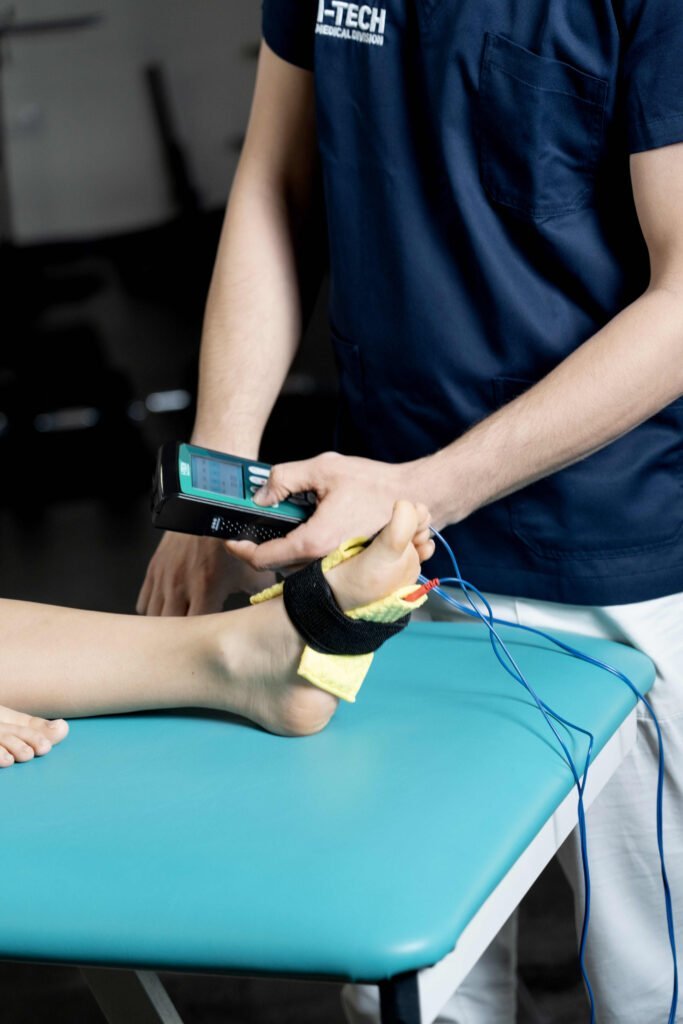Iontophoresis, a term derived from the Greek for “ion transport,” is an established therapeutic technique that uses direct current to “travel” drugs through our skin. Like an electric ambulance, the current creates a field that guides charged drugs, based on their polarity, to the desired target.
What can be the applications for iontophoresis?
Keep following and find out!
How is iontophoresis performed and how long does a session last?
Before we talk about the specifics of the therapy, let’s go over the various types of iontophoresis and what mechanisms make this particular form of electrotherapy effective!
Types of Iontophoresis
There are two main types of iontophoresis:
- Continuous Iontophoresis: Uses a low-intensity direct current.
- Pulsed Iontophoresis: Uses direct current pulses with high-intensity cut-off periods for longer application times.
These two modes give approximately the same effects, it all depends on the person’s tolerance for the electrical stimuli
The mechanisms of drug delivery
Just on the subject of efficacy, let’s look at what factors promote better results of iontophoresis:
- Drug’s molecular size and charge: drugs with smaller molecular size and higher charge penetrate more easily through the skin.
- Drug concentration: A higher concentration of the drug in the ionized solution promotes its transport.
- Treatment duration: Longer treatment allows for greater penetration of the drug.
- Skin characteristics: Thinner, more hydrated skin allows easier passage of medications.
- General body hydration: good general hydration promotes treatment success.
But how does it work?
Before treatment you will have to sprinkle the area of the affected with an ionized substance containing the drug; in some cases the drug will be distributed on one of the two electrodes (the one corresponding to the polarity of the drug).
Next, two electrodes, one positive and one negative, are placed on the skin and connected to a DC generator. The low-intensity current creates an electric field that “pushes” the charged drugs through the skin, reaching deep tissues where they can carry out their action. This is the “secret” that makes iontophoresis so effective!
For an effective iontophoresis session, the minimum recommended duration is 20 minutes, but, as we shall see, prolonged treatment allows for greater penetration of the drug into the skin with better results!
Why use Iontophoresis and what diseases is it indicated for?
Imagine that you have a nagging joint pain. With iontophoresis, the doctor can administer a pain-relieving drug directly to the affected area, without the need for needles.
The direct current creates a gap in the skin barrier, allowing the drug to penetrate deeply and reach the site of pain, where it can deliver its beneficial action in a targeted manner and with minimal side effects. Iontophoresis can also be used in self-treatment by the patient, after proper training, of course.
But what kinds of conditions can be treated by iontophoresis?
- Musculoskeletal inflammation and pain.
- Muscle and bone injuries.
- Degenerative or inflammatory joint diseases.
- Peyrone’s disease.
In addition to fighting pain, iontophoresis proves to be a valuable ally in the management of hyperhidrosis.
Hyperhidrosis is excessive sweating that affects patients’ quality of life, causing social and occupational discomfort and emotional distress.
Primary hyperhidrosis is excessive, bilateral, symmetrical sweating localized to the armpits, palms, soles of the feet, or craniofacial region and not caused by any other underlying condition. Secondary hyperhidrosis can be focal or generalized and is caused by an underlying medical condition or the use of medication. In this case, the medication used is often an anticholinergic, which acts on the sweat glands by reducing sweat production.
The application of this technique on the hands, feet, or armpits provides effective control over sweating, improving the quality of life of sufferers.
On hands and feet it is usually applied with the help of a basin filled with a few millimeters of natural water (tap water), where the two electrodes (positive and negative) on which hands or feet are placed are immersed. Alternatively, special sponges soaked in water can be used

What are the effects and benefits of iontophoresis?
Having better understood what Iontophoresis is, let’s go into more detail to see what the beneficial effects of this treatment are:
Advantages of iontophoresis
Iontophoresis offers numerous advantages over other routes of drug delivery, including:
- Noninvasive administration: does not require injections or needles, making it a more comfortable procedure for patients.
- Targeted action: the drug is delivered directly to the affected area, minimizing systemic side effects (no excipients are used).
- Personalized dosing: the dose of the drug can be adjusted according to the patient’s needs.
- High effectiveness: in many cases, iontophoresis proves more effective than other routes of administration.
- Increased excitability threshold: during iontophoresis treatment, the excitability threshold of the fibers is raised, thus reducing pain sensation.
Contraindications of Iontophoresis
Let’s go through all what can be considered contraindications of iontophoresis.
Although this is generally a safe and well-tolerated technique. like any treatment, it has some contraindications that are mandatorily listed within the user manuals, the main ones being:
- If the sponges are not well wetted, you run the risk of burns
- presence of dermatitis and abrasions (do not place electrodes above these areas)
- Altered skin sensitivity;
- Blood coagulation diseases;
- Presence of metallic media in the tissues traversed by the current;
- States of capillary fragility;
- presence of pacemakers, defibrillators or other electronic life-support devices at the point of treatment;
- Severe arrhythmias;
Is direct current bad for you?
The current density used is sufficient to allow the drug to penetrate through the pores of the skin but is not painful. The sensation the patient may experience is a definite tingling sensation over the electrode area. In case of pain, it is necessary to reduce the intensity of the pulse.
Does Iontophoresis Hurt?
The question “Does iontophoresis hurt?” is common among patients. In this study, iontophoresis treatments were shown to be generally well tolerated, with minimal side effects.
Occasional side effects include transient erythema and edema at the penile or abdominal electrode site, but no serious side effects have been observed.
On what parts of the body can it be performed?
Iontophoresis is a versatile technique that can be used on different parts of the body to treat various conditions.
In fact, its noninvasive nature is perfect for ensuring it uses a low-intensity electric current to promote drug absorption through the skin, making it effective in multiple situations.
Parts of the body where iontophoresis can be applied
- Hands and feet: often used to treat hyperhidrosis (excessive sweating).
- Elbows and knees: useful for reducing inflammation in tendinitis and arthritis.
- Neck and back: effective for relieving muscle pain and tension: Back iontophoresis can be useful for relieving sciatic nerve pain, for example.
- Penis: Penile Iontophoresis is an optimal procedure to treat Peyrone’s disease.
If you suffer from this condition and wish to explore innovative treatment options, consult your physician to assess whether Iontophoresis for Peyronie’s may be right for you. As you read on, you’ll find out everything you need to know about this promising treatment technique.
Iontophoresis for Peyronie's disease
If you are looking for an effective solution to treat Peyronie’s disease, penile iontophoresis may be the right option for you.
This noninvasive treatment uses a low-intensity electric current to promote drug absorption directly into the body of the penis, thereby reducing penile curvature and relieving associated pain.
Advantages of iontophoresis for Peyronie’s disease
- Noninvasive: no surgery required.
- Painless: treatment is generally well tolerated.
- Effective: can significantly improve quality of life.
- Safe: widely recommended by specialists.
STUDY ON THE USE OF IONTOPHORESIS FOR PEYRONIE’S DISEASE
In this study, a self-adhesive plastic vessel was applied to the skin of the penis over the plaque. The vessel was filled with a specific solution to treat plaques related to this condition.
The positive electrode of a current generator was connected to the vessel, while the cathode was attached to the lower abdomen. Iontophoresis was performed using a continuous current at 5 mA for 20 minutes, three times a week for a total of 10 treatments. Treatment was continued until symptoms resolved or until the patient was satisfied.
Of the 100 patients treated:
- 79 had a palpable cavernous plaque.
- 19 presented diffuse induration and enlargement of the intercavernous septum.
- 2 had no definite plaques.
Efficacy of Iontophoresis in Peyronie’s disease
- Pain was eliminated in 63% of patients and significantly improved in 33%, with complete or significant reduction as early as 2-3 weeks of therapy.
- Plaque was reduced in 39% of patients and disappeared completely in 14%.
- In patients with intercavernous septal induration, 74% showed no improvement, while 21% showed a reduction in size.
- Penile deviation improved significantly in 16% of patients and less pronounced in 21%, while in 55% there was no change.
Conclusions
Many conditions (such as precisely Peyronie’s) require painful injections, local anesthesia, and often do not distribute drugs evenly to be treated. In contrast, treating them with iontophoresis is painless and makes the drugs distribute evenly over the lesion.
This technique uses an electric field to improve transdermal penetration of drugs. Iontophoresis has been shown to be particularly effective for painful lesions lasting less than 12 months and for penile deviations of less than 60 degrees. It should be considered a first-choice noninvasive therapy for Peyronie’s disease.
Thank you for reading this article! If you think it might be helpful please share it, and if you need an Iontophoresis machine, find out about all I-Tech Medical Division dealers near you here!
Bibliography
- IONTOPHORESIS FOR TREATMENT OF PEYRONIE’S DISEASE – Riedl, Plas, Engelhardt, Daha, Pfluger – The journal of urology – Jan 2000






